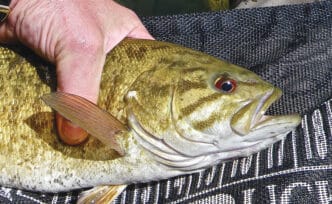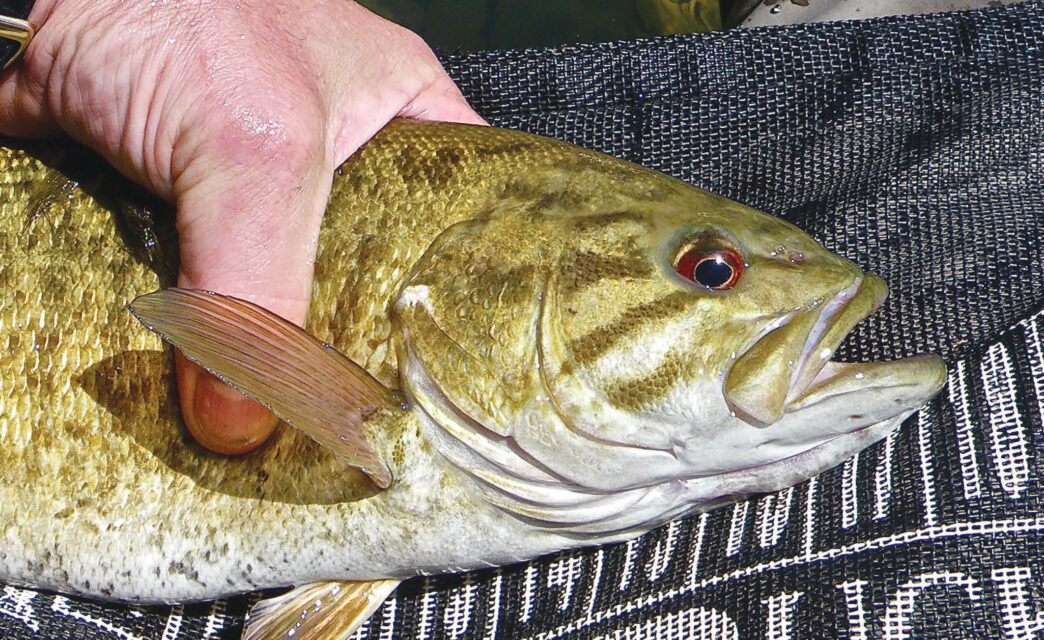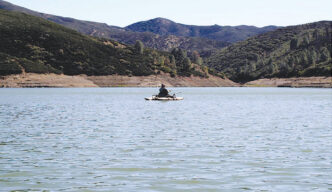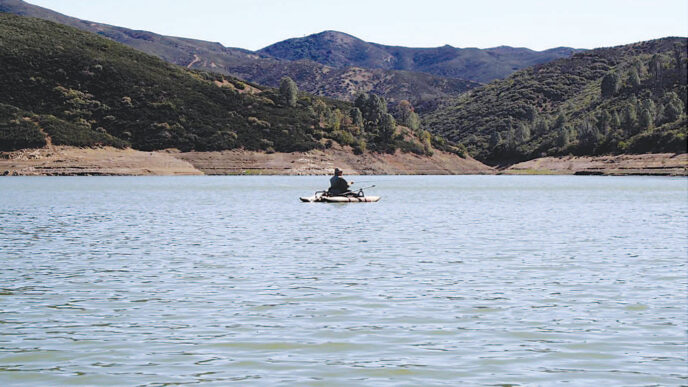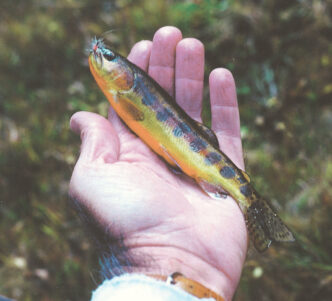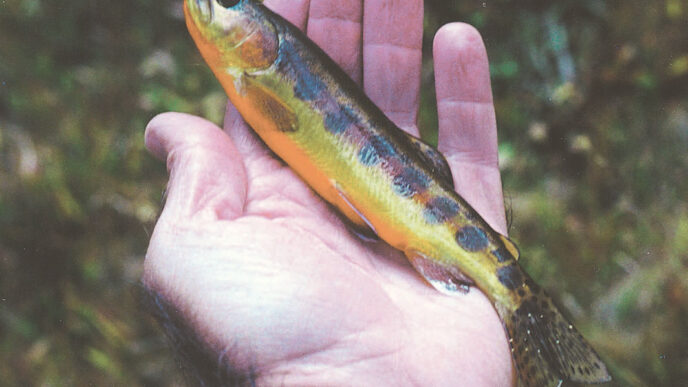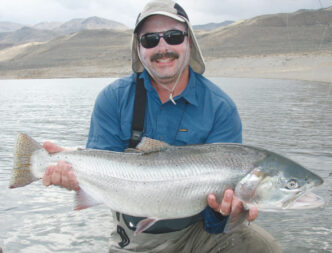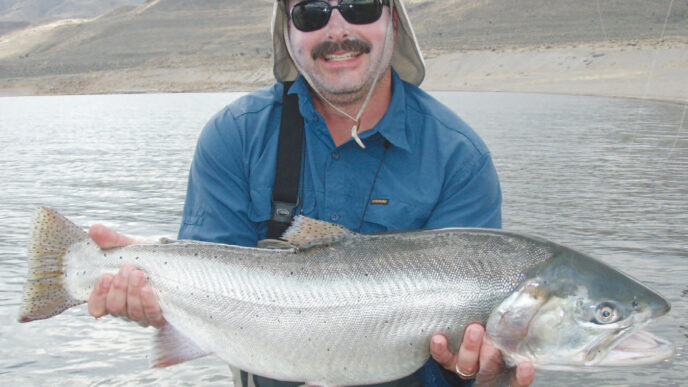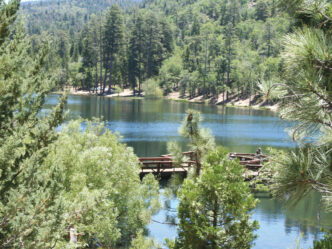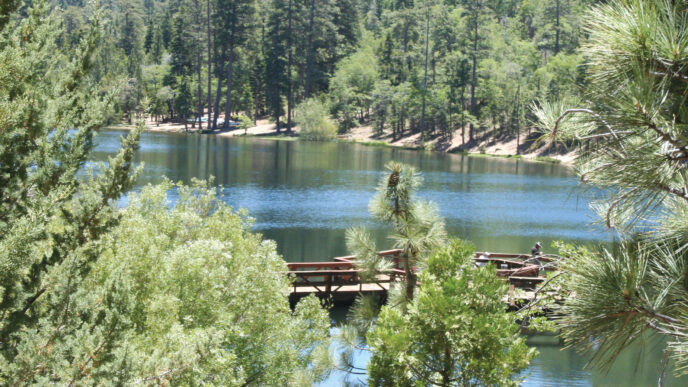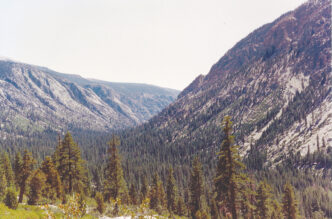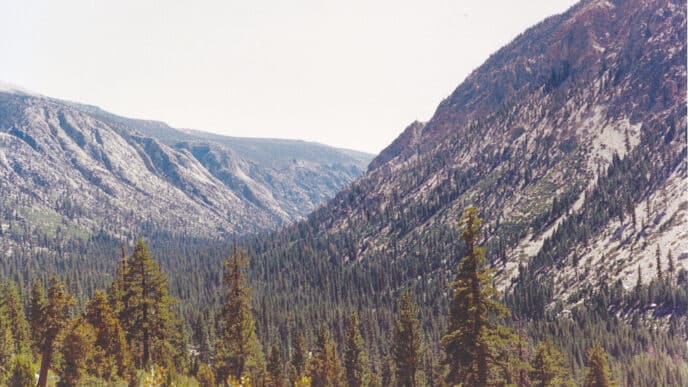Many California fly fishers begin their angling experience with a 5-weight rod and a visit to a well-known trout stream such as the upper Sacramento River or Hot Creek. Those of us who catch the fever quickly add new equipment and new destinations. For the two of us, our fishing trips have increasingly led to warmwater species, starting with largemouth bass. Then we discovered the thrill of catching smallmouth bass, affectionately known as bronzebacks.
Smallmouths have many attractions for the fly fisher, not least of which is their fight at the end of a line. Additionally, large numbers are found in foothill reservoirs within relatively close proximity to large population centers in California, and smallmouths make good targets for fly fishers from spring to fall — especially in the late spring, when our trout rivers swell with runoff and angling options for trout become limited. Scotts Flat Reservoir, near Nevada City, is one destination that has become a regular part of our fishing agenda, especially because of its robust smallmouth bass population.
Located about 10 miles outside of Nevada City, Scotts Flat was formed when the Nevada Irrigation District flooded an old Scottish miners’ colony in 1948 — hence the name. A powerhouse was added in 1984. The lake occupies 725 acres, sits at an elevation of just over 3,000 feet, and consists of 7.5 miles of shoreline. Scotts Flat is about a mile across and maxes out at 60 to 80 feet deep when full. It is fed primarily by Deer Creek, and the impounded water is used by homes and businesses in the area and for irrigation needs, while the powerhouse generates electricity for local consumers.
Although Scotts Flat attracts significant numbers of recreational users at times, it is generally very fly-fishing friendly.
Its affordable boat-launching and camping facilities are complemented by regulations banning jet skis. Boating and jet ski opportunities at nearby Englebright, Bullards Bar, and Rollins Reservoirs divert a lot of recreational traffic from Scotts Flat. The lake is bordered by an attractive forest, with home sites set back from the shore. The south shore still shows evidence of the hydraulic mining done by the Scottish miners during the Gold Rush era.
Downstream of the main lake is a much smaller impoundment known both as Lower Scotts Flat and as Deer Creek Reservoir. The lower lake draws cool water from the powerhouse and is largely a stocked rainbow trout fishery.
Most of the access at the main lake is private, and shore fishing opportunities are somewhat limited. There are a few gravelly flats in front of certain campsites where a bit of wading is possible. The area to the left of the campground’s day-use section has good structure, as well as a wheelchair accessible fishing dock. Stocked rainbows in the 12-inch range are often taken along with bass in these spots, including along drop-offs near structure.
However, steep drop-offs limit wading and necessitate using either a motorized or nonmotorized watercraft to fish much of the lake effectively. If you don’t have a bass boat, your best choice is a float tube or a pontoon boat. These will allow a careful, hands-free approach and facilitate accurate casting to the shallows from just offshore. A pontoon boat is helpful for covering longer distances around the perimeter of the lake, and one with oars is very useful when the wind picks up. If you fish from a large pontoon boat, a long-handled landing net is quite handy.
Launching access is available on both the north and south sides of the lake. The main access is on the north side, where you enter the recreational area through a kiosk and can launch a motorized boat at the marina or a nonmotorized craft at the dayuse area. The south-side access is a privately maintained launch within the Cascade Shores residential area. (See the “If You Go . . .” sidebar for fee information and directions to both launch areas.)
A third option is to launch from a campsite on the lake. If you plan ahead and are fortunate enough to get a lakeside campsite, you will be able to launch a float tube, canoe, or kayak right from camp. The lake’s campground accepts reservations and offers a lovely setting. In our experience, it is also relatively quiet during the week in the spring.
Fly casters and spin fishers visit the lake for a wide variety of species: rainbow and brown trout, smallmouth and largemouth bass, small kokanee salmon, catfish, and bluegills. Catchable-size rainbow trout are stocked each spring at both the upper and lower Scotts Flat Reservoirs. While holdover rainbows (about 16 to 18 inches) and resident browns (over 10 pounds) are present, their populations are relatively small, so they can be more difficult to hook.
The Smallmouth Fishery
We have found that the Scotts Flat smallmouth population, especially in the spring, is currently healthy and represents a challenging and exciting sport fishery. In this lake, smallmouths outnumber largemouths, which spawn about a month later. Competent fly fishers can expect to hook many one-pound smallmouths at Scotts Flat, with the possibility of landing a 17-to-20-inch trophy in the three-to-five pound range.
Lake fishing for smallmouths, like most bass fishing, picks up in the spring, when hungry fish move into the shallows in preparation for spawning. This usually starts when water temperatures reach the middle 50s, generally in April. Prespawn bass begin to stage on or near areas having nest-friendly, gravelly bottoms, as opposed to mud bottoms. Fishing usually peaks when water temperatures are in the 60s and the drowned trees have budded out, providing more cover. During these times, smallmouths can be taken all day long, especially when the sky is overcast.
As summer approaches, fly fishing is more of an early morning and evening game. Top-water action can be good, and is great fun. Keep moving to find the fish. Deeper trolling is also effective. When rain and low-pressure fronts arrive, however, bass tend to move into deeper water and are less willing to feed.
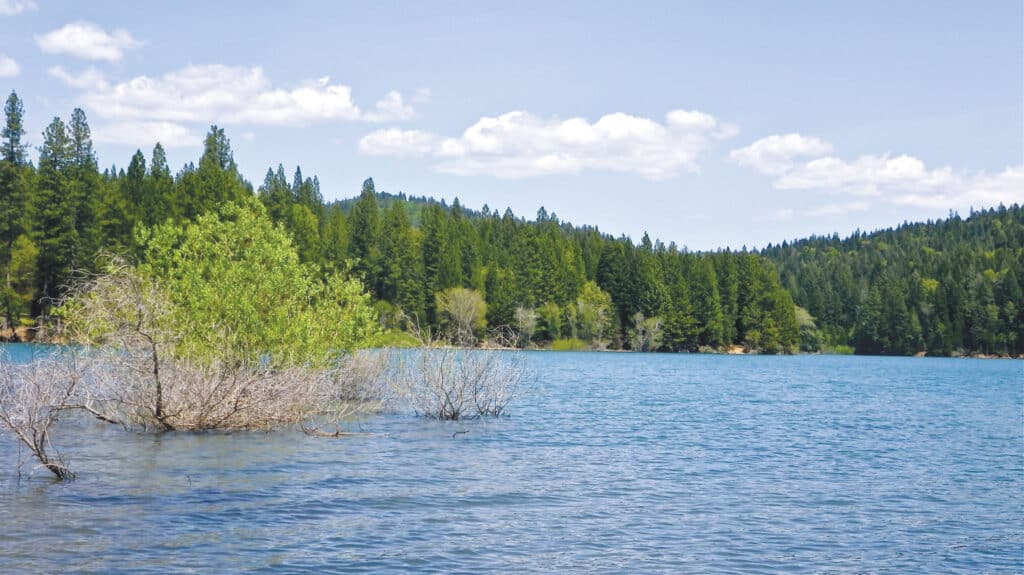
In autumn, both smallmouths and largemouths return to the shallows as the temperatures drop and the days shorten. Anglers who brave the winter weather of February and March on Scotts Flat tend to fish for browns and holdover rainbows.
Gear, Flies, and Tactics
Many people are familiar with smallmouths only as an occasional by-catch — small fish taken while angling for trout in rivers. The larger smallmouths that are present in Scotts Flat fight much harder and will definitely test your equipment. When fishing from nonmotorized craft, we like 9-foot 6-weight rods, including saltwater designs that have a fighting butt. These easily handle weighted flies on sinking lines as well as the larger flies that are often used on bass-taper floating lines. Equally important is the ability of this kind of rod to muscle any large hooked fish away from leader-busting brush. Keeping careful pressure on hooked fish is important, because smallmouth are experts at throwing flies during their head-shaking leaps.
Trent Pridemore’s article “Gearing Up for Bass” (California Fly Fisher, May/June 2012) has excellent advice on choices of equipment that work well on Scotts Flat Reservoir. He writes: “Stealth in bass fishing is just as important as in trout fishing, and that includes the leader you use.” The water is quite clear on Scotts Flat, and we agree that a tapered leader of 9 feet ending in 0X to 3X fluorocarbon tippet will result in more hookups. Stout leaders will help you land large fish and will minimize break-offs due to snags.
Intermediate sinking lines are effective with both long and somewhat shorter leaders. Shorten your leader as you fish deeper water with sinking lines.
Pridemore, who frequently fishes Scotts Flat, points out that both pond smelt and warmouth bass are present in the lake as forage fish. This probably explains why Clousers (olive or chartreuse over white) and Woolly Buggers in olives and browns are among the more effective fly patterns. Add a bit of orange into your streamers, and they may be taken for crayfish, a favorite smallmouth food. In the evening, top-water flies, such as the classic smallmouth pattern, the Sneaky Pete Slider, can be productive at times. Whichever fly you use, attach it with a loop knot such as the Nonslip Mono Loop, to allow for more natural movement.
Variants of the old Jack Shaw and Mike Andreasen pattern, the Mohair Leech, work well for smallmouths and trout on Scotts Flat Reservoir. (See the accompanying fly recipe.) Shades of olive and brown perform best and are very effective in the spring. Use an intermediate line and a long leader. Cast as close to structure as you can, favoring the shady side, if possible, while keeping your distance and using a cautious approach. (Many fly fishers fail to connect with any smallmouths of decent size because they ignore one or more of these recommendations.) Allow the fly to sink, lower your rod tip into the water, and retrieve the fly with pauses. Short strips are the norm, but don’t be afraid to vary your retrieve. Be prepared for some aggressive strikes, especially when making long strips. Use a strip strike to set the hook and continue stripping if the fish misses the grab. Don’t overfish any one area, no matter how good it looks. Keep moving and come back later.
Keep a close eye out for flying ant “hatches” on Scotts Flat, too. The wind on Scotts Flat Reservoir not only attracts sailboat owners, but also blows large numbers of flying ants (as well as beetles, spiders, and bees) onto the water. When the bass and trout are on the ants (size 10 to 14), fishing can be good all day long.
Finding Smallmouth Bass
The drowned brush and trees along much of the lake are excellent places to look for bass. Water that is three to eight feet deep is a good place to start. Many coves, including the campground marina cove itself, offer decent fishing. Areas close to the south-shore marina are also popular. On sunny days, try shady areas near shore drop-offs, as well as the deeper water along points. The dam consists of riprap and holds fish at various levels as it descends into deep water.
On windy days, protected areas and areas downwind of points can hold willing fish. The long inlet arm is quite protected from the wind and is a favorite location for those seeking both trout and bass, but reaching it requires a moderately long kick or paddle from the launch areas.
Finding such sheltered areas can be important, because the wind comes up nearly every day on Scotts Flat, sometimes starting as early as late morning. Often the wind switches from the southeast to the southwest, and whitecaps are not uncommon. Be prepared by having a personal flotation device on your craft. If fishing from a float tube or a pontoon boat, wear a wading belt, which will help prevent water from quickly filling your waders if you are overtopped by waves or somehow capsize, and consider carrying a whistle for signaling in the event of an emergency. Cellphone service is spotty at Scotts Flat Reservoir. Go only as far from your launch site as your physical condition and experience warrant, and plan to come back with the wind behind you, if possible. Fortunately, the wind often dies down as evening approaches.
In our estimation, smallmouth bass are worth seeking as a challenging and exciting alternative to trout. There are many other lakes similar to Scotts Flat with respect to climate, structure, and biomass, and these are worth exploring, as well. Examples include Lake Almanor, Lake Britton, Butt Lake, Lake Clementine, Jenkinson Lake, Lewiston Lake, Lake Tulloch, Lake Cuyamaca, and Lake Siskiyou. Having a higher elevation and a later season, the three main Truckee-area reservoirs, Boca, Prosser, and Stampede, also support fishable populations of smallmouths. A state record 9.1-pound smallmouth was caught in 1976 in Clair Engle (Trinity) Lake, and Lake Pardee has been serving up some huge fish in recent years. Of course, smallmouths also can be found in the lower elevations of west-slope Sierra waters that drain into the Sacramento and San Joaquin Rivers, starting with the Kern River in the south. Wherever you choose to fish in California for bronze backs, be prepared for aggressive hits, strong tugs, and impressive acrobatics. You’ll have a great time.
Mohair Leech
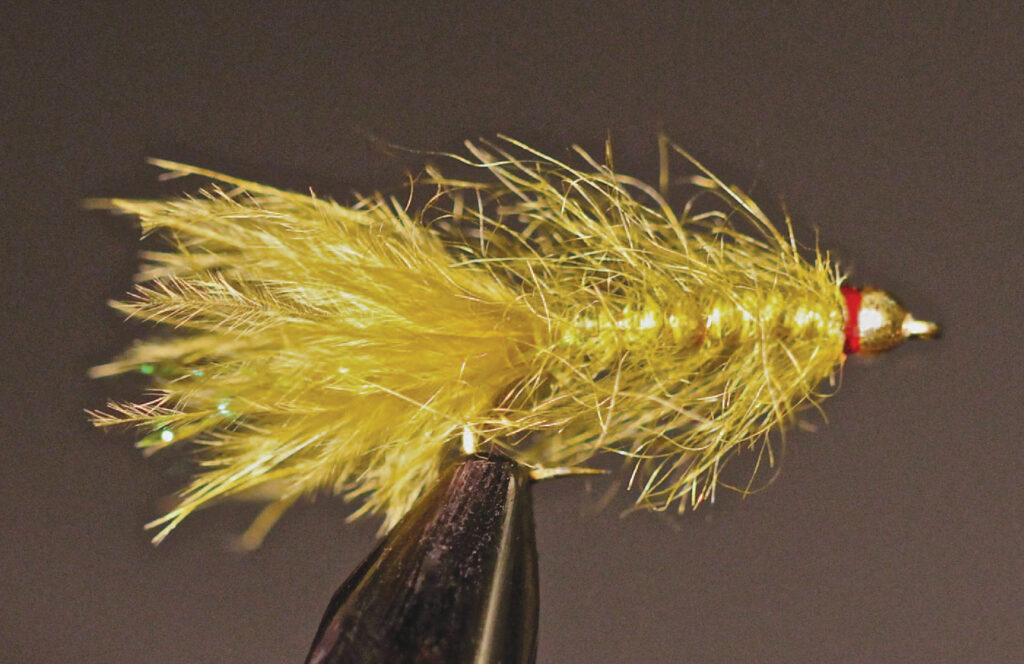
Hook: Tiemco 200R, size 10
Bead: Slotted 7/64-inch tungsten bead
Thread: Olive 8/0
Tail: Olive marabou and two strands of olive Krystal Flash
Rib: Fine copper wire
Body: Olive mohair yarn or angora goat dubbing, picked out
Gills: Red 8/0 thread in a band behind the bead
If You Go . . .
Getting to Scotts Flat Reservoir is not difficult, but don’t rely completely on commercial mapping services as you approach the lake. If coming from the west, such as the Bay Area or Sacramento, travel to Nevada City via either Highway 49 from the Auburn exit off Interstate 80 or via Highway 174 from the I-80 Colfax exit. Then proceed on Highway 20 east for about six miles past Nevada City. Turn south onto Scotts Flat Road just before you reach the Five Mile Inn, a local restaurant with a large sign. Then drive approximately 4 miles (not 3.3 miles, as the mapping services might tell you) until you reach the entry kiosk. Driving time from the Bay Area is approximately 2.5 hours. To reach Scotts Flat from an eastern location such as Truckee, take Highway 20 west to the turnoff at Scotts Flat Road and follow the same directions as above.
Depending on the season, the entrance kiosk may or may not be staffed. If it’s staffed, register and pay there. Otherwise, drive past the kiosk until you see a trailer on the left with an “Office” sign. Go inside to obtain a day-use pass and pay your fees, which are listed on the operator’s Web site at rates_and_directions.html. From 7:00 A.M. to 3:00 P.M., day-use passes for a vehicle and up to four persons cost $6.50 ($4.00 after 4:00 P.M.).
If you choose to launch at the marina, make the first right after passing through the kiosk. The marina rents a variety of boats; its contact number is (530) 265-0413. If you are heading for the day-use area, go straight after passing the kiosk and follow the signs, which will take you through part of the campground and eventually to the parking area at the end of a loop road. This is the most convenient place to launch nontrailered watercraft.
To get to the Cascade Shores launch area on the south shore, exit Highway 49 in Nevada City and find the main downtown street, Broad Street, which becomes Boulder Street as it heads east out of town, then bear right on Red Dog Road. Turn left on Quaker Hill Cross Road (which becomes Banner Quaker Hill), then drive through a housing subdivision to the launch site on Lake Lane by turning left on Pasquale, right on Cascade, right on Gaston Drive, and left onto Lake Lane. The launch fee is less than at the campground marina (only $3.00), and you can either park outside the gate and walk in for $1.50 or enter through the gate and park in the lot for $6.50.
For camping reservations and information, go to http://www.scottsflatlake.net or phone (530) 265-5302. Reservations are accepted and are strongly encouraged if you are intent on getting a lakeside site or plan to camp during a busy period. The campground has flush toilets, sinks, pay showers, potable water, and barbecues/fire-rings. There are bears in the area, but there are no bear boxes, so plan to store your food wisely.
If shopping locally for food, drink, and camping essentials, your options include the Harmony Ridge Market, 18848 Highway 20, open 8:00 A.M. to 7:00 or 8:00 P.M.) and the Cascades Shores General Store, 16552 Pasquale Road, Nevada City, open 9:00 A.M. to 9:00 P.M. seven days a week. More limited supplies are available at the marina and campground stores, although they are typically open only on weekends in the spring.
The Scotts Flat area offers a vibrant dining and winery scene centered in Nevada City. Information can be found at http://gonevadacounty.com/food-wine.
Kirston Koths and Bob Marshak



